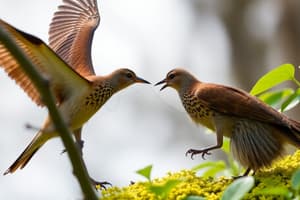Podcast
Questions and Answers
What is competition?
What is competition?
- An interaction that occurs only among different species
- An interaction that negatively affects organisms when they rely on shared, limited resources (correct)
- An interaction promoting resource sharing
- An interaction that benefits organisms
What is intraspecific competition?
What is intraspecific competition?
Competition between members of the same species.
What is interspecific competition?
What is interspecific competition?
Competition between members of different species.
What are the two ways to compete?
What are the two ways to compete?
What is interference in competition?
What is interference in competition?
What is exploitation in competition?
What is exploitation in competition?
What are sublethal effects?
What are sublethal effects?
What does the Competitive Exclusion Principle state?
What does the Competitive Exclusion Principle state?
What promotes coexistence among competing species?
What promotes coexistence among competing species?
What is niche partitioning?
What is niche partitioning?
What is character displacement?
What is character displacement?
What is exponential population growth?
What is exponential population growth?
What is logistic growth?
What is logistic growth?
What does the Lotka-Volterra competition model describe?
What does the Lotka-Volterra competition model describe?
What are invasive competitors?
What are invasive competitors?
What are the two foundational facts to life?
What are the two foundational facts to life?
What does selection favor in terms of energy allocation?
What does selection favor in terms of energy allocation?
What are the two ways a parent could invest in offspring?
What are the two ways a parent could invest in offspring?
What does survival entail in terms of energy allocation?
What does survival entail in terms of energy allocation?
What is reproductive effort?
What is reproductive effort?
What does k-selected refer to?
What does k-selected refer to?
What does r-selected refer to?
What does r-selected refer to?
How is relative offspring size calculated?
How is relative offspring size calculated?
How is relative reproduction lifespan calculated?
How is relative reproduction lifespan calculated?
Flashcards are hidden until you start studying
Study Notes
Competition
- Interaction negatively impacts organisms relying on shared, limited resources.
Intraspecific Competition
- Occurs between members of the same species.
- Involves both kin and non-kin.
- Considered the strongest form of competition.
Interspecific Competition
- Takes place between individuals of different species.
Competition Methods
- Interference: Direct competition involving conflict or aggression.
- Exploitation: Indirect competition where organisms use resources more efficiently without contact.
Subelethal Effects
- Negative impacts on organisms that do not lead to death, such as slowed growth or reduced reproductive capacity.
Competitive Exclusion Principle
- Predicts that no coexistence leads to the more efficient species reproducing faster, potentially driving the weaker species to extinction.
Coexistence
- Selection favors individuals that exploit parts of their fundamental niche with minimal competition.
Niche Partitioning
- Avoiding competition conserves energy compared to engaging in direct competition.
- Traits that enhance success in lower competition niches are favored.
Character Displacement
- Phenotypic changes in populations result from selection pressure to reduce competition.
Population Growth
- Exponential Growth: Unchecked population increase models.
- Logistic Growth: Accounts for intraspecific competition, stabilizing population as resources become limited.
Lotka-Volterra Competition Model
- A mathematical model that describes the dynamics of biological systems in which two species compete for the same resources.
Invasive Competitors
- Invasive species are significant environmental threats due to their competitive advantage over native species for resources.
Foundational Facts to Life
- Gene Transmission: Success is defined by the ability to pass on genes.
- Energy Limitation: Organisms must make energy trade-offs to survive.
Selection of Energy Allocation
- Natural selection favors individuals that allocate energy toward strategies enhancing reproductive success.
Parental Investment Strategies
- Investment can be made in either larger offspring size or in increasing the number of offspring.
Survival Strategy
- Energy allocation towards longevity enhances survival prospects.
Reproductive Effort
- Energy dedicated to producing and nurturing offspring.
K-Selected Species
- Competitive ability prioritized over reproduction; efficient resource use leads to equilibrium.
R-Selected Species
- Emphasis on reproductive output rather than competitive ability.
Relative Offspring Size
- Offspring mass as a proportion of parental mass, indicating investment in size.
Relative Reproductive Life Span
- The ratio of time spent reproducing to the time taken to reach reproductive maturity, reflecting life history strategies.
Studying That Suits You
Use AI to generate personalized quizzes and flashcards to suit your learning preferences.




